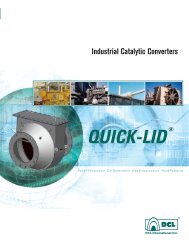Filtros para partículas de motores diesel - DSF Technologies
Filtros para partículas de motores diesel - DSF Technologies
Filtros para partículas de motores diesel - DSF Technologies
Create successful ePaper yourself
Turn your PDF publications into a flip-book with our unique Google optimized e-Paper software.
Eficacia <strong>de</strong> la conversión<br />
(En <strong>partículas</strong>, por conteo)**<br />
Eficacia <strong>de</strong> la conversión<br />
(En <strong>partículas</strong>, por masa)<br />
Cómo<br />
INSTALARLO<br />
Eficacia <strong>de</strong> la conversión<br />
(CO)<br />
El monolito cerámico, con baño catalizador, tiene<br />
canales largos y estrechos, abiertos en un extremo<br />
y cerrados en el otro. El gas <strong>de</strong>l escape se ve<br />
forzado a salir pasando por las pare<strong>de</strong>s <strong>de</strong>l filtro,<br />
don<strong>de</strong> las <strong>partículas</strong> (el hollín) quedan<br />
atrapadas. Con el gas <strong>de</strong> escape a alta<br />
temperatura, las <strong>partículas</strong> <strong>de</strong> hollín ar<strong>de</strong>n y se<br />
transforman en dióxido <strong>de</strong> carbono inocuo. El filtro<br />
también <strong>de</strong>struye el monóxido <strong>de</strong> carbono (CO) y<br />
los hidrocarburos (HC) <strong>de</strong>l combustible <strong>diesel</strong>.<br />
REACCIONES BÁSICAS<br />
C (hollín) + O 2 CO 2<br />
CO + ½ O 2 CO 2<br />
C x H y + O 2 CO 2 + H 2O<br />
Eficacia <strong>de</strong> la conversión<br />
(HC)<br />
Efecto sobre el NOx<br />
>99% 70-95% 90% 80% 300-360 o El coeficiente<br />
<strong>de</strong> NO2/NO<br />
pue<strong>de</strong><br />
aumentar<br />
C<br />
>99% 70-95% - - 380-420 o El coeficiente<br />
<strong>de</strong> NO2/NO<br />
no cambia<br />
C<br />
Temperatura típica <strong>de</strong>l<br />
punto <strong>de</strong> equilibrio<br />
Requiere<br />
< 50 p.p.m.<br />
Sin<br />
restricciones<br />
Azufre en el combustible<br />
7.5 kPa<br />
(limpio)<br />
20 kPa<br />
(cargado)<br />
5 kPa<br />
(limpio)<br />
20 kPa<br />
(cargado)<br />
Presión típica <strong>de</strong> retorno<br />
* <strong>partículas</strong> pequeñas y súper pequeñas (<strong>de</strong> 10 a 500 nm <strong>de</strong> diámetro)



